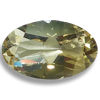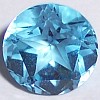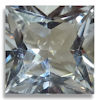
Topaz gets a bad rap. It’s my birthstone so I’m here to defend its beauty and uniqueness. It may be the most commonly misrepresented gem. Many people including some that should know better call brown Quartz “smokey Topaz”. If this isn’t bothersome enough, I often hear Citrine referred to as “gold Topaz” as well. To alleviate the confusion many jewelers refer to Topaz as “precious Topaz” to avoid the public’s confusion between Topaz and Quartz or worse considering them the same thing. After you read this article, I hope you’ll be my advocate and explain the difference to those that are still lost.
Quartz and Topaz are completely different minerals. Topaz is harder with a Mohs hardness of 8 while Quartz is 7. Their refractive indices are similar but their specific gravities are so distinctly different any decent sized gem can be identified just by tossing it around in your hand. With a specific gravity of 3.5 versus only 2.6 for Quartz the difference in weight for similar sized gems is easily noticeable. It may be difficult to sense the difference in a 6mm gem (Topaz will be about 1ct while an Amethyst is only about .7ct), but take a 16x12 oval in each hand and the Quartz will feel like a piece of plastic compared to the Topaz (almost 10cts versus about 7.5cts for similar cuts).
Topaz may not be as common as Quartz but it is still relatively common in pale blue and white. These materials are irradiated to make the very popular Topaz colors of Swiss Blue and London Blue. They have received bad press lately because of concerns over these gems being sold “hot”. The Swiss and London blue material does have a short period of mild risk but the NRC and other worldwide organizations monitor this and set restrictions on the few facilities worldwide that treat Topaz andother gems with radiation. If you have any concern at all, you should feel comfortable in asking your supplier about their source and certification. I’ve never heard of any case of even minor health risk from any Swiss or London Topaz. The NRC does monitor the situation and although they would like to enforce some sort of licensing program for the sale of these goods, it seems they’ve recognized that the health risk is negligible and requiring companies to license and test is counter productive.
The rare colors of Topaz are gold, orange and pink. Pink is the rarest and therefore the most valuable. Any colors with pink tints like the peach colors and orange are still quite lovely and sought after. Although included gems in the rich colors are available in large sizes, clean pink and peach Topaz is quite rare and somewhat expensive. Golden Topaz is only moderately pricey and is the typical color associated with the November birthstone. Brown Topaz is often available in the market but beware of this material because it will likely fade to white with exposure to heat and sunlight.
Brazil is the biggest supplier of Topaz especially the natural golden material, however, large quantities of the material are found in many parts of the world including Sri Lanka, Nigeria and Mexico. Many of these countries will irradiate and/or heat treat the gems and rough before they export, so be sure you buy from someone you trust who knows their sources and enhancements. The irradiated blues are stable but the browns and enhanced golds have some risk of fading over time.
Topaz has what is called “perfect cleavage”. This means that if the rough or gem is sharply struck it will break with a perfect flat break. This can be very helpful in quickly identifying white Topaz rough from white Quartz rough. If the rough has perfectly flat breaks it is likely Topaz. Also remember the difference in specific gravity as well. Take a known Quartz crystal of similar size and compare it to the Topaz. You’ll likely sense a distinct difference in weight if the rough is Topaz. Of course, Topaz will also scratch Quartz easier than Quartz will scratch itself but often you don’t want to damage your gems. The perfect cleavage is a difficulty for the cutter as well so you might want to practice on some cheap Topaz before you cut the prize rough.




